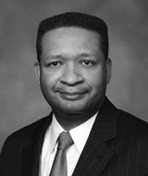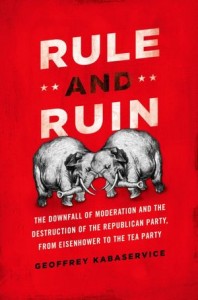 I’m half admiring and half-critical of Rule and Ruin, Geoffrey Kabaservice’s exploration of the decline of moderates as a political force in the Republican Party. On the admiring side, he dusts off an important, and mostly forgotten, phase in the turbulent sixties, when centrist Republicans simultaneously rescued civil rights legislation and fashioned a critique of bureaucratic liberalism that has held up well over the last four decades. Not only is it a vivid account of the era’s characters, it’s a valiant reminder that the unrestrained growth of both government and the safety net can be criticized for reasons that don’t contain a racist or hard-hearted foundation.
I’m half admiring and half-critical of Rule and Ruin, Geoffrey Kabaservice’s exploration of the decline of moderates as a political force in the Republican Party. On the admiring side, he dusts off an important, and mostly forgotten, phase in the turbulent sixties, when centrist Republicans simultaneously rescued civil rights legislation and fashioned a critique of bureaucratic liberalism that has held up well over the last four decades. Not only is it a vivid account of the era’s characters, it’s a valiant reminder that the unrestrained growth of both government and the safety net can be criticized for reasons that don’t contain a racist or hard-hearted foundation.
On the critical side, an elegant narrative that is balanced and reserved in its political assessments for about 300 pages turns rushed and simplistic in its last hundred pages. Kabaservice on the post-Nixon era buys and re-sells the stock line that Reagan Republicans pulled the GOP away from its moorings to a right-wing fantasy-land, and that intemperate ideologues have refashioned the party in a way that has steadily erased any moderates or even thoughtful conservatives. It’s hardly wrong to fault the philosophical intolerance that does exist on the Right, but Kabaservice’s frustration with it leads him to minimize other large factors: first, the book has too little to say about the numerous centrifugal forces in American life that have pulled both the left and right away from the middle, including the surge of grassroots, cause based fundraising; the aggregation of special interests on both sides; and the explosion of a cable culture that profits off polarization. Any one of these developments is a book-length project, and the limited attention Kabaservice gives them puts too much weight on the machinations of politicians and kingmakers at the expense of forces much bigger than they were.
Second, and here Kabaservice is only mimicking a bias that dominates the punditry zone, the book acts if ideological orthodoxy is a solely conservative force. He makes the slightest of references to the similar decline of moderates in the Democratic Party in the past decade—an erosion so pervasive that it has done in ten years what Republicans at least took forty plus years to do. So, to a degree the media virtually never acknowledge, each party is essentially a collection of major premises that are rarely examined by the ranks of elected officials in either camp.
The Republican orthodoxy on taxes is familiar and it has done its share to constrain policymakers for over a generation. The impact of the religious right on national and particularly southern Republicans is also undeniable. But consider the following: there is no cohort of elected federal Democrats who question the sustainability of Social Security or who critique the unprogressive financing structure at the core of Medicare, which divvies out benefits three times the value of a senior’s contributions. There are a negligible number of current elected Democrats, and none who have viable national ambitions, who take issue with the proposition that the constitution and basic justice protect abortion rights and same sex relationship equality. The absence of Democratic critics of the Occupy Wall Street agenda (as opposed to its tactics) was telling last year, and reveals the disappearance of the pro-growth wing of the party that dominated the nineties.
And the story goes on: while there were 36 Democratic House votes against the Affordable Care Act, not a single Democratic senator or congressman urges its repeal or even the striking down of its individual mandate provision; no Democratic politician at the national or congressional level dares to endorse photo ID requirements for voters; and there is no serious Democratic official who challenges the sacred cows of the teacher unions, tenure and opposition to vouchers.
I am also struck that Kabaservice, who is meticulous in his dissection of the sixties, slips so easily into an overstatement of what the conservative reign has meant within the Republican Party. As Michael Kinsley, a pretty thorough-going liberal, observed in the New York Times this January, the supposed conservative domination of the last three decades has not exactly turned the country on its head: as he notes, not a single major government program has been undone, abortion and affirmative action survive, gay rights expand, and not a single right-wing constitutional amendment has been enacted. The limited win total has as much to do with splits and disagreements within Republican ranks as with liberal effectiveness, which undercuts Kabaservice’s premise that conservatism is so monolithic.
Had Kabaservice written a more nuanced account of the post-Reagan era, which conceded the movement of both parties toward their respective bases and which charted the course of policies more than personalities, the trade-off would have been fewer book-sales and fewer plaudits from a media which is enthralled by his portrait of Republicans going off the rails. But he might have gained the virtue of shedding light on what is really the major trend in 21st century politics: the inability of either side to get much done once in power. Ironically, in the book’s last pages, after getting the dismay over the far right out of his system, Kabaservice turns to the theme of gridlock, and makes a compelling, albeit brief case, why the decline of moderates has contributed to it: the absence of a center has meant no natural base of deal-makers, no platform for the kind of smart compromises that achieved welfare reform in 1996 or Social Security reform in the mid eighties.
It is never clear whether Kabaservice actually means to influence Republicans or conservatives. By denigrating the period from 1980 to the present as “ruin” or “destruction”—when to conservatives it is an era in which they rose from near death to become the most popular philosophy in the country—he leaves the sense that persuading his subject is not exactly his goal. But it is in the end, in the book’s reflective, powerful conclusion, that he gets around to making a conservative friendly case for why some alternative Republican governing vision does deserve another turn on the stage.
As he argues, one major virtue of centrist Republicans is that they defended federalism and personal accountability when a major portion of liberalism was bent on rolling over both principles. The centrists wrestled with liberals over the vitality of free markets and the limited returns of massive spending, and the notion that moderates aided and abetted the sixties explosion of government is more flawed memory than fact. Furthermore, the Republican center engaged policy challenges around poverty and public education without the compromising strings of ties to liberal interests; and in so doing, they helped their party fend off the notion that it was better at opposition than governing. In other words, these “centrists” did the conservative cause much good during times when Republicans were in deep peril.
The kind of moderate Republican the press wants to revive is one to the left of every tenet in the modern Republican universe—that’s not likely to happen at a leadership level anymore than a right of center Democrat will flourish in time for 2016. But if “moderate” is amended to mean a conservatism that is reform-oriented, middle-class friendly, not exclusively entrenched in the wonders of an unfettered market–in other word, a conservatism with many of the old moderate virtues–it’s a force that is actually gaining ground. It’s recognizable in the writings of right-leaning intellectuals like David Frum, Ross Douthat and Reihan Salam, and in the gubernatorial successes of Jeb Bush, Bobby Jindal, and Chris Christie. With any luck, it’s this new conservatism that will deserve a book in about five to ten years time.
(Cross-posted, with permission of the author, at OfficialArturDavis.com)










Leave a Reply